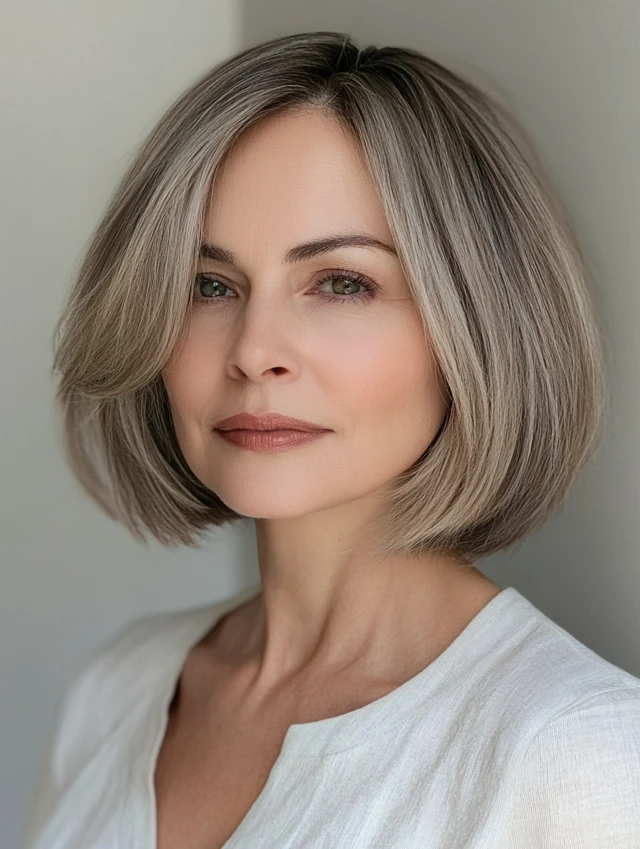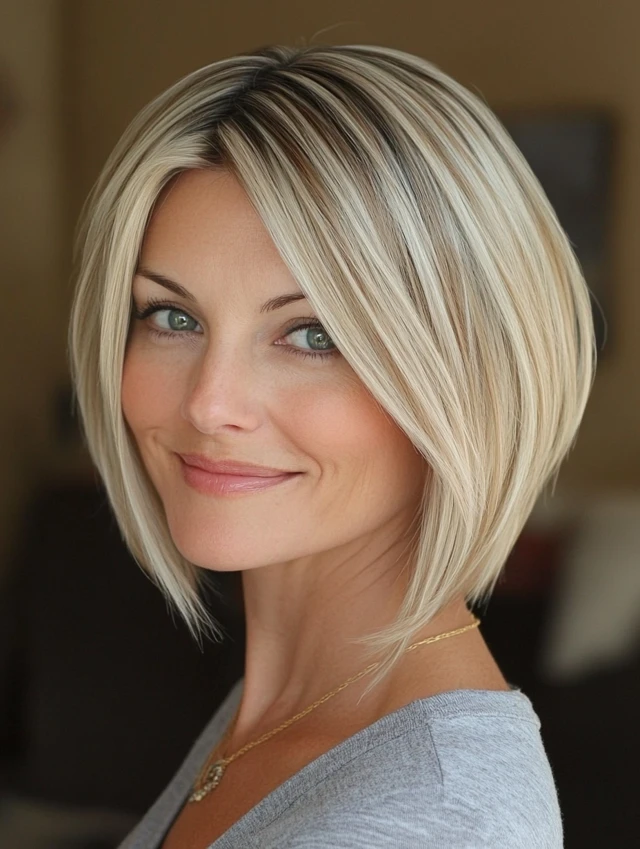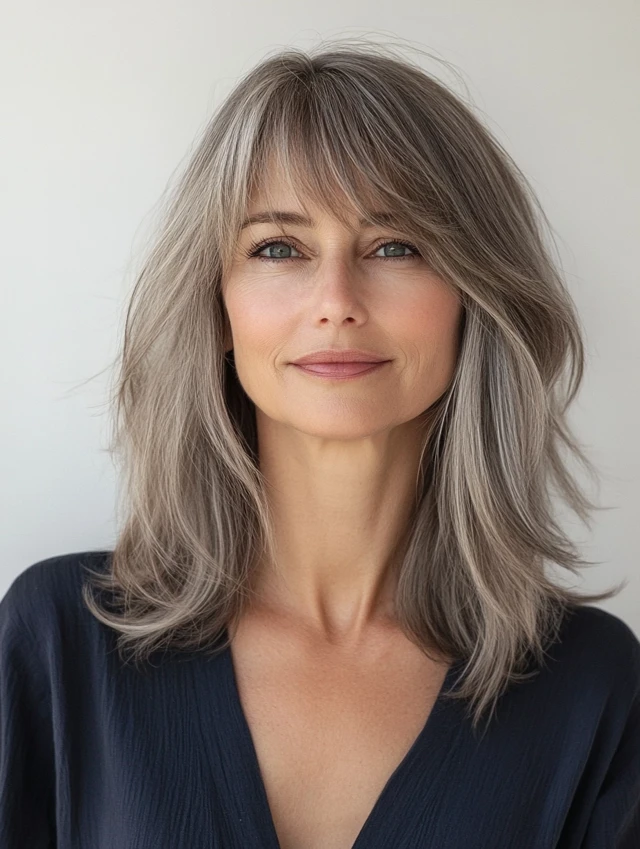The Real Beauty of Aging Hair
There’s a softness that comes with age—not just in our tone, our touch, or our outlook, but in our hair. It thins. It changes texture. It shifts color. And while the beauty industry has long tried to paint this as something to battle, those of us who’ve lived through five decades or more know the truth: this softness carries power.
Thin, fine hair after 50 doesn’t mean the end of great hairstyles. It marks the beginning of styling with intention—with knowledge of what works, what feels good, and what reflects the woman you’ve become. This is a season where every strand can speak. And what it says is entirely up to you.
Because hair isn’t just about what’s on your head. It’s about how you show up in the world—with ease, with confidence, and with the quiet wisdom of someone who no longer needs permission to shine.
Understanding the Changes: Why Hair Feels Different After 50
By the time you’re in your fifties, your hair has lived many lives. Hormonal shifts, particularly those related to menopause, begin to slow down follicle activity. The strands themselves become finer. The overall volume reduces. In some places, you may notice more scalp showing, especially around the part or crown.
This isn’t about vanity—it’s biology. Estrogen levels drop. Growth phases shorten. Hair cycles out quicker and regrows more slowly. And yet, even in its new form, your hair still holds beauty, still holds style, still holds possibility.
Acknowledging these changes isn’t about grieving your younger hair. It’s about getting curious about your current one. Because this version of your hair might be different—but it’s no less worthy of being styled with care.
Moving Toward Ease, Not Effort
Something changes in your fifties—not just in your hair, but in your values. You start wanting things to feel easier. More streamlined. More “you.” And hairstyles are no exception.
Gone are the days of spending 45 minutes teasing roots or blowing out every strand to perfection. You want styles that look effortless and feel effortless—but that still leave you looking polished, present, and pulled together.
That means cuts and styles that work with the hair you have, not against it. It means shapes that lift and sculpt without needing daily intervention. It means celebrating movement and texture—not constantly trying to control it.
There’s a special kind of elegance in that kind of simplicity. And it’s not just practical. It’s empowering.
Styling Thin, Fine Hair Without Hiding It
For years, the beauty message to women with thinning hair has been clear: cover it up. Add volume. Add extensions. Add thickness. And while there’s nothing wrong with a little help, the pressure to hide often misses the point entirely.
Because styling isn’t about hiding. It’s about framing. Framing your face. Framing your personality. Framing your freedom.
So, when you sit in that styling chair—or stand in front of your mirror—it’s worth asking: how do I want to feel when I leave this moment? Do I want to feel light? Do I want to feel defined? Do I want my eyes to pop, my cheekbones to show, my spirit to feel visible?
With thin, fine hair, styling becomes a process of revealing, not concealing. And with the right cut, product, and attitude, that hair can feel as full of life as you are.
Haircuts That Feel Like a Breath of Fresh Air
Haircuts after 50—and particularly for thin hair—become more about shape than length. A blunt cut might add fullness around the base. Soft layering can create movement and lift. A pixie can feel playful. A chin-length bob can feel classic. What matters most is how it moves with you.
Ask your stylist for techniques that create the illusion of thickness without adding weight. Internal layering. Textured ends. A cut that frames your jawline or draws the eye upward.
And trust the gut feeling you get when the cape comes off. You’ll know when a cut makes you feel like you.
Color and Dimension: Lifting the Look Without Overdoing It
Color plays a powerful role in how thin, fine hair is perceived. Too much depth, and the hair can look even flatter. Too much lightness, and the hair risks looking see-through. The magic lies in dimension.
Strategic highlights add light-catching contrast and make the hair appear fuller. Lowlighting near the roots or underneath adds depth. Toners can make silver hair shine brighter or reduce yellowing.
Even fully embracing gray or white hair can bring a whole new softness to your overall aesthetic—especially when paired with a modern cut and healthy sheen.
Color at this stage of life is about enhancement, not transformation. Think glow, not cover-up. Think tone, not trick.
Scalp First, Style Second
One of the biggest secrets to styling thin, fine hair is to care for your scalp like you care for your skin.
A healthy scalp means stronger roots and longer retention. Gentle exfoliation removes buildup. Lightweight serums with caffeine or rosemary oil can stimulate blood flow. Shampoo less frequently, but with products that nourish, not strip.
When the foundation is cared for, the styling becomes easier. Because healthy roots produce stronger hair—no matter how thin it is.
And when your scalp is happy? The whole style feels better.
Texture Is Your Friend, Not Your Enemy
If you were raised on blow-dry culture, this might be hard to believe—but the more natural texture you allow, the fuller your hair will look.
Thin hair thrives with texture. That doesn’t mean frizz. It means a little movement. A little lift. A little grit.
Use texturizing spray to add body at the roots. Try soft waves to create bounce. Opt for volumizing mousse on damp hair instead of heavy serums or creams. And if you do use heat, focus on the crown and face-framing pieces—not every inch.
Let your hair breathe. Let it move. Let it be what it is, with a little styling support—not suppression.
The Role of the Right Tools
Styling thin, fine hair isn’t about collecting more gadgets—it’s about choosing better ones.
Lightweight blow dryers with diffuser attachments. Round brushes with vented bodies. Flat irons with adjustable heat. Teasing combs with soft bristles. Velcro rollers that add volume without damage.
These tools don’t just style—they protect. And when your hair is already delicate, protection is everything.
If you’re not sure where to start, invest in one high-quality heat tool that does multiple things well—and use it with a heat protectant every time.
Your hair might be fine. But your styling? It can still be fierce.
Letting Go of the Myths
There’s a long list of myths about aging and hair.
That you should cut it short. That you should stop coloring. That you should “tone it down.”
Let’s throw all that out.
There’s no rulebook for how hair over 50 should look—especially when it’s thin. You can wear it in a bun. You can wear it down. You can pin it, curl it, slick it, braid it. You can add bangs. You can go silver. You can do absolutely nothing and still look radiant.
Because the only thing thin hair really needs is permission to be worn proudly.
And the only thing you really need is to remember who you are—without all the noise.
Check out this Ideas and Save your Favorite.
1. The Volumizing Pixie Cut
A short pixie with strategic layering is a game-changer for thin hair. It keeps things light and airy at the ends while lifting at the crown for instant fullness.
Why it works: Minimal weight equals maximum volume. The close crop on the sides draws the eye upward, giving the illusion of thicker hair.
Styling Tips:
- Use a volumizing mousse or root-lifter before blow-drying.
- Finger-style with a lightweight texture paste for separation.
- Add bangs or side fringe for softness.
1

2

3

4

Best For: Oval, square, or heart-shaped faces; wash-and-go lifestyles.
2. Chin-Length Bob with Side Part
The classic bob never goes out of style—and with a side part, it adds asymmetry that breaks up flatness at the crown.
Why it works: Keeps hair compact and healthy, making fine strands look bouncier and fuller.
Styling Tips:
- Blow-dry with a round brush to curve the ends under.
- Flip your part to the opposite side occasionally for more volume.
- Use a light shine serum to keep the ends smooth but not greasy.
1

2

3

4

Best For: Thin, straight to slightly wavy hair; round or heart-shaped faces.
3. Layered Shoulder-Length Cut
Layers at shoulder-length prevent fine hair from looking limp while maintaining enough length for styling variety.
Why it works: The layering removes bulk and boosts movement, especially around the crown and face.
Styling Tips:
- Apply volumizing spray and blow-dry in sections.
- Curl the ends outward for lift and bounce.
- Use a wide-tooth comb rather than a brush to preserve texture.
1

2

3

4

Best For: Women who want flexibility (updos, clips, etc.) without losing fullness.
4. Textured Crop with Bangs
This cropped cut adds movement and energy with feathered bangs and texture throughout the crown. Great for making the most of short, fine hair.
Why it works: It brings attention to the eyes and cheekbones while minimizing the appearance of sparse strands.
Styling Tips:
- Style with your fingers and a dry texture spray.
- Use a little wax or pomade to define pieces.
- Bangs should be soft and side-swept for a youthful effect.
1

2

3

4

Best For: Petite faces, women with glasses, or those who want an easy daily style.
5. The Inverted Bob
An inverted bob (shorter in the back, longer in the front) builds volume in the back of the head, giving a thicker, fuller look.
Why it works: The angled cut creates structure and the illusion of more density.
Styling Tips:
- Use a root-boosting spray at the back of the crown.
- Blow-dry with a paddle brush and flip the ends slightly forward.
- Maintain with trims every 6–8 weeks for a crisp shape.
1

2

3

4

Best For: Square or round faces, especially with thinning at the crown.
6. Side-Swept Short Layers
Short, layered hair swept to one side offers lift and a touch of drama. It’s flattering and perfect for adding volume to the top and sides.
Why it works: The side sweep tricks the eye into seeing more density, while the layers give motion.
Styling Tips:
- Apply mousse at the roots and blow-dry in the opposite direction of your part.
- Use a curling wand to add bend at the ends.
- Finish with a volumizing hairspray that won’t weigh you down.
1

2

3

4

Best For: Fine, straight hair types looking for a modern update.
7. Collarbone-Length Cut with Curtain Bangs
This length is light enough to avoid pulling fine hair down but long enough to feel feminine. Curtain bangs draw attention upward and frame the face softly.
Why it works: Adds fullness near the face, softening features and creating vertical lift.
Styling Tips:
- Use a round brush to style curtain bangs away from the face.
- Apply texturizing mist to mid-lengths and scrunch for added body.
- Keep ends slightly curled for a fuller appearance.
1

2

3

4

Best For: Oval and long face shapes; wavy or straight textures.
8. Tapered Cut with Volume Crown
This cropped style focuses on stacking volume at the crown and tapering the nape and sides, which adds instant lift.
Why it works: Creates a rounded, full silhouette ideal for fine or thinning hair at the back of the scalp.
Styling Tips:
- Use root-lifting powder or mousse before blow-drying.
- Tease the crown slightly and smooth over with a comb.
- Keep the sides tight and polished.
1

2

3

4

Best For: Women with thinning at the crown or receding sides.
9. Blunt Bob with Soft Ends
A blunt bob with very minimal layering is ideal for creating the illusion of thicker ends. Keep it just above the shoulders for maximum fullness.
Why it works: The even cut gives structure and prevents the stringy look that fine hair can develop.
Styling Tips:
- Blow-dry with a volumizing round brush.
- Use a flat iron to bend the tips under.
- Finish with a dry, matte texture spray to build body.
1

2

3

4

Best For: Fine, straight hair types who want a sleek but volumized silhouette.
10. Modern Pixie with Side Bangs
A pixie doesn’t have to be stiff or overly short. Add long side bangs and layers at the crown for a trendy, feminine feel.
Why it works: The longer top creates the illusion of thicker hair, while the shorter sides give a clean profile.
Styling Tips:
- Blow-dry the front up and over for volume.
- Piece out sections with pomade or styling cream.
- Play with accessories like thin headbands or jeweled clips.
1

2

3

4

Best For: All face shapes; especially flattering for confident, low-maintenance styling.
Accessories That Actually Work
If your hair is too fine for heavy clips or thick ponytails, that doesn’t mean you can’t play with accessories.
Light barrettes. Thin silk scrunchies. Minimalist headbands. Soft fabric-covered clips. These items can elevate your style without weighing it down.
Even something as simple as a decorative pin near your temple or a clip at the nape can change the entire mood of your look.
Let accessories be the punctuation—not the sentence. Add them with confidence. Let them speak. Then let them go when you don’t feel like fussing.
Because the most important accessory is the one wearing them—you.
What Confidence Really Looks Like After 50
It doesn’t look like perfect volume or polished blowouts. It looks like ease.
It looks like knowing that your hair might not be thick—but your joy is. Your strength is. Your history is. And that’s what people see first when you walk into a room.
Confidence after 50 is knowing that styling your hair isn’t about looking younger. It’s about feeling centered. It’s about getting up in the morning and saying, “This feels like me. This looks like me. This moves with me.”
It’s not about being high-maintenance. It’s about being highly present.
And when your hair reflects that? The rest falls into place.
Final Thoughts: Let It Be Light, Let It Be Yours
There’s a grace that comes with age that no stylist, product, or trend can teach.
It shows up in how you carry yourself. In how you smile. In how you style your hair not for approval—but for expression.
Thin, fine hair over 50 isn’t a limitation. It’s a canvas. And with the right shape, the right texture, and the right touch of intention, it can tell a story of experience, freedom, and beauty that’s impossible to replicate.
So whether you pin it up, part it down the middle, let it fly, or smooth it behind your ears, wear your hair like you wear your years:
With pride. With peace. With power.